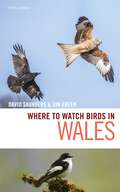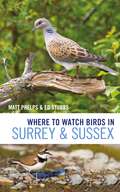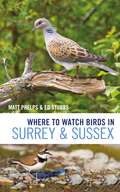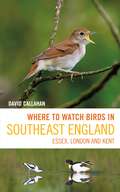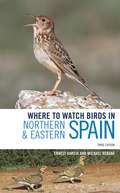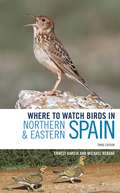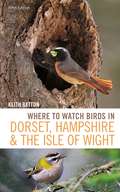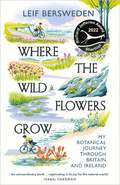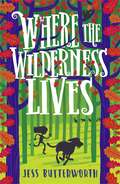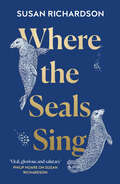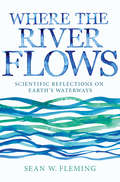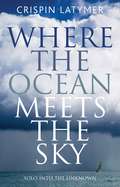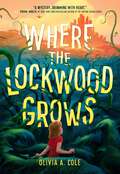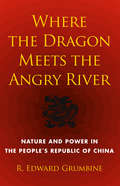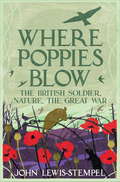- Table View
- List View
Where to Watch Birds in Wales (Where to Watch Birds)
by David Saunders Jon GreenThe definitive guide to the birdwatching sites of Wales.Wales remains one of the most alluring regions for birdwatchers; its range of habitats ensures a wide variety of species amidst the often spectacular scenery. Now in its fifth edition, Where to Watch Birds in Wales remains an invaluable and most trusted site guide for birdwatching in Wales. This new edition features many new sites, and includes updated maps to the sites and fully revised and expanded text.This is an essential guide for all birdwatchers living in or visiting this land of hills, valleys, moors and mountains.
Where to Watch Birds in Surrey and Sussex (Where to Watch Birds)
by Matthew Phelps Ed StubbsThis site guide covers the counties of East Sussex, West Sussex and Surrey, including sites in southwest Greater London. From the heaths of Surrey to the chalky grassland of the North and South Downs, the great forests of the Weald and the headlands, shingle beaches and river valleys of England's south coast, these three counties are a bird-rich part of the country, with perhaps the most diverse range of habitats in the country, and all within easy distance of London, the southwest part of which contains birding sites such as Barnes wetland centre.This new book by Matthew Phelps and Ed Stubbs is the definitive guide to the birding highlights of the region. It contains a comprehensive review of all the major sites, and many lesser-known ones, with maps, notes on access, and information on target species and when to visit. Where to Watch Birds in Surrey and Sussex is indispensable for any birder heading to this bird-rich region, or anyone in London who wants to head south to enjoy some of the best birding England can offer.
Where to Watch Birds in Surrey and Sussex (Where to Watch Birds)
by Matthew Phelps Ed StubbsThis site guide covers the counties of East Sussex, West Sussex and Surrey, including sites in southwest Greater London. From the heaths of Surrey to the chalky grassland of the North and South Downs, the great forests of the Weald and the headlands, shingle beaches and river valleys of England's south coast, these three counties are a bird-rich part of the country, with perhaps the most diverse range of habitats in the country, and all within easy distance of London, the southwest part of which contains birding sites such as Barnes wetland centre.This new book by Matthew Phelps and Ed Stubbs is the definitive guide to the birding highlights of the region. It contains a comprehensive review of all the major sites, and many lesser-known ones, with maps, notes on access, and information on target species and when to visit. Where to Watch Birds in Surrey and Sussex is indispensable for any birder heading to this bird-rich region, or anyone in London who wants to head south to enjoy some of the best birding England can offer.
Where to Watch Birds in Southeast England: Essex, London and Kent (Where to Watch Birds)
by David CallahanThe definitive site guide to a surprisingly bird-rich corner of England – Kent, Essex and the Greater London area.From the deep forests of Kent to the low-lying mudflats, beaches and saltmarshes of the Greater Thames Estuary, this ecologically rich area of England attracts vast numbers of wildfowl and waders. The region boasts many internationally and nationally important reserves including Rainham Marshes and Cliffe Pools, while Dungeness in Kent is one of Britain's best known birding hotspots for vagrant species such as Penduline Tit and Kentish Plover. London itself contains numerous birdwatching sites including Barnes and Woodberry Wetlands, along with some of the best spots in Britain for scarcities such as Lesser Spotted Woodpecker and Black Redstart. From Marsh Harrier and Firecrest to Curlew and Lapwing, there is plenty for birdwatchers to enjoy while exploring the parks, wetlands, woodlands and coast of southeast England. Written by life-long birdwatcher David Callahan, this is the definitive guide to the birding highlights of the region. It contains a comprehensive review of all the major sites and many lesser-known ones, with maps, notes on access, and information on target species and when to visit. Where to Watch Birds in Southeast England is indispensable for any birder exploring the region, or anyone in London wanting to head out to the countryside and enjoy a slice of our rich avian heritage.
Where to Watch Birds in Southeast England: Essex, London and Kent (Where to Watch Birds)
by David CallahanThe definitive site guide to a surprisingly bird-rich corner of England – Kent, Essex and the Greater London area.From the deep forests of Kent to the low-lying mudflats, beaches and saltmarshes of the Greater Thames Estuary, this ecologically rich area of England attracts vast numbers of wildfowl and waders. The region boasts many internationally and nationally important reserves including Rainham Marshes and Cliffe Pools, while Dungeness in Kent is one of Britain's best known birding hotspots for vagrant species such as Penduline Tit and Kentish Plover. London itself contains numerous birdwatching sites including Barnes and Woodberry Wetlands, along with some of the best spots in Britain for scarcities such as Lesser Spotted Woodpecker and Black Redstart. From Marsh Harrier and Firecrest to Curlew and Lapwing, there is plenty for birdwatchers to enjoy while exploring the parks, wetlands, woodlands and coast of southeast England. Written by life-long birdwatcher David Callahan, this is the definitive guide to the birding highlights of the region. It contains a comprehensive review of all the major sites and many lesser-known ones, with maps, notes on access, and information on target species and when to visit. Where to Watch Birds in Southeast England is indispensable for any birder exploring the region, or anyone in London wanting to head out to the countryside and enjoy a slice of our rich avian heritage.
Where to Watch Birds in South America
by Nigel WheatleyA unique field guide and reference, Where to Watch Birds in South America is designed to help the avid birder and the general wildlife enthusiast organize eventful journeys throughout the richest continent for birds, where the species number over three thousand. This book covers more than two hundred of the best sites for birdwatching, and includes the archipelagos of Trinidad and Tobago, the Galapagos and Falkland Islands, the Netherland Antilles, and part of Antarctica. The reader will find details of every species that is endemic to particular countries, and will learn where and when best to see such birds as the scarlet ibis, Andean condor, harpy eagle, sunbittern, macaw, toucan, jacamar, antbird, and cotinga. The text is enhanced by nearly one hundred maps and fifty line drawings. There are even hints as to where species not seen for decades may be rediscovered.This guide begins with an introduction to the continent and its birds then deals with particular countries and archipelagos. The site details include bird lists, a list of other wildlife present, and the latest advice on where to look for birds. For the traveler, there is information on transport, accommodations, safety, and health, and answers to various strategic questions: Which countries support the most species? How many sites must be visited to see most of them? How long does this take? When is the best time to go? Whether a first-time visitor to South America or a seasoned traveler there, the reader will find this guide immensely useful in making the most out of the trip.Originally published in 1994.The Princeton Legacy Library uses the latest print-on-demand technology to again make available previously out-of-print books from the distinguished backlist of Princeton University Press. These editions preserve the original texts of these important books while presenting them in durable paperback and hardcover editions. The goal of the Princeton Legacy Library is to vastly increase access to the rich scholarly heritage found in the thousands of books published by Princeton University Press since its founding in 1905.
Where to Watch Birds in Northern and Eastern Spain
by Ernest Garcia Michael RebaneThe definitive guide to finding birds in Northern and Eastern Spain.This region embraces an impressive range of habitats from the Pyrenees to the sun-drenched Catalan coast. As a consequence the area is rich in birdlife and full of potential for visiting birders. Almost 200 sites are described in this fully updated third edition, with full coverage of terms of habitat, access and the species to be seen. The accounts are illustrated by detailed maps and beautiful line drawings of selected species.Where to Watch Birds in Northern and Eastern Spain includes comprehensive coverage of all thirteen autonomous regions, a descriptive list of all the resident, visiting and rare birds to be found, as well as advice on watching seabirds from key sites like Estaca de Bares. This edition provides better coverage than ever to one of the most popular birding destinations in Europe.
Where to Watch Birds in Northern and Eastern Spain (Where To Watch Birds Ser.)
by Ernest Garcia Michael RebaneThe definitive guide to finding birds in Northern and Eastern Spain.This region embraces an impressive range of habitats from the Pyrenees to the sun-drenched Catalan coast. As a consequence the area is rich in birdlife and full of potential for visiting birders. Almost 200 sites are described in this fully updated third edition, with full coverage of terms of habitat, access and the species to be seen. The accounts are illustrated by detailed maps and beautiful line drawings of selected species.Where to Watch Birds in Northern and Eastern Spain includes comprehensive coverage of all thirteen autonomous regions, a descriptive list of all the resident, visiting and rare birds to be found, as well as advice on watching seabirds from key sites like Estaca de Bares. This edition provides better coverage than ever to one of the most popular birding destinations in Europe.
Where to Watch Birds in East Anglia: Cambridgeshire, Norfolk and Suffolk
by David CallahanEast Anglia – the jewel in the crown of British birding. The counties of Norfolk, Suffolk and Cambridgeshire represent the most popular region for birders and naturalists to visit in the British Isles, whether to see wintering flocks of geese and waders, rare vagrants, scarce breeding birds such as cranes and bitterns, or just to soak up the countryside, be it fen, broad, coastal dune, breckland, heath or down. East Anglia really does have it all. This new book by David Callahan is the definitive guide to the birding highlights of the region. It contains a comprehensive review of all the major sites, and many lesser-known ones, with maps, notes on access, and information on target species and when to visit. Where to Watch Birds in East Anglia is indispensable for any birder heading to this bird-rich corner of England.
Where to Watch Birds in East Anglia: Cambridgeshire, Norfolk and Suffolk
by David CallahanEast Anglia – the jewel in the crown of British birding. The counties of Norfolk, Suffolk and Cambridgeshire represent the most popular region for birders and naturalists to visit in the British Isles, whether to see wintering flocks of geese and waders, rare vagrants, scarce breeding birds such as cranes and bitterns, or just to soak up the countryside, be it fen, broad, coastal dune, breckland, heath or down. East Anglia really does have it all. This new book by David Callahan is the definitive guide to the birding highlights of the region. It contains a comprehensive review of all the major sites, and many lesser-known ones, with maps, notes on access, and information on target species and when to visit. Where to Watch Birds in East Anglia is indispensable for any birder heading to this bird-rich corner of England.
Where to Watch Birds in Dorset, Hampshire and the Isle of Wight: 5th Edition (Where to Watch Birds)
by Keith BettonWhether you're seeking Firecrests or Hawfinch in the New Forest, Osprey in Dorset or eagles on the Isle of Wight, this book tells you where to go, what you'll see and when to see it. Keith Betton's fully revised and updated fifth edition of Where to Watch Birds in Dorset, Hampshire and the Isle of Wight is the essential site guide for any birdwatcher visiting or resident in the area.This book contains a comprehensive review of the area's significant birdwatching sites, providing all the information necessary to make the most of each and every trip, whatever the time of year. This edition also incorporates new sites and revised mapping throughout and has notes on access and target species. This book is an indispensable resource for birders in this bird-rich sweep of southern England.
Where to Watch Birds in Dorset, Hampshire and the Isle of Wight: 5th Edition (Where to Watch Birds)
by Keith BettonWhether you're seeking Firecrests or Hawfinch in the New Forest, Osprey in Dorset or eagles on the Isle of Wight, this book tells you where to go, what you'll see and when to see it. Keith Betton's fully revised and updated fifth edition of Where to Watch Birds in Dorset, Hampshire and the Isle of Wight is the essential site guide for any birdwatcher visiting or resident in the area.This book contains a comprehensive review of the area's significant birdwatching sites, providing all the information necessary to make the most of each and every trip, whatever the time of year. This edition also incorporates new sites and revised mapping throughout and has notes on access and target species. This book is an indispensable resource for birders in this bird-rich sweep of southern England.
Where to Watch Birds in Africa
by Nigel WheatleyWhere to Watch Birds in Africa is a field guide designed to help birders and general wildlife enthusiasts organize the most enriching trips possible throughout this great continent. From Morocco to Madagascar, this book presents over 200 bird-watching sites in detail and describes the species endemic to Africa. The traveler will find practical information on climate, transportation, accommodations, health, and safety as well as advice on a number of strategic questions: Where can we see birds that epitomize the continent? Which country supports the best cross-section of species and the most endemics? How many sites must be visited to see most of these birds? How much time do these trips take and when is the best time to go? Featuring over one hundred maps and fifty-one line drawings, this book is not only a guide but also a handy reference.Following a chapter on how to use the book, there is an introduction to the continent and its birds. The countries, archipelagos, and islands are then dealt with alphabetically. General introductions to each country are followed by site details, which include bird lists; a list of other wildlife present, if applicable; and the latest information on where to look for the best birds.Originally published in 1995.The Princeton Legacy Library uses the latest print-on-demand technology to again make available previously out-of-print books from the distinguished backlist of Princeton University Press. These editions preserve the original texts of these important books while presenting them in durable paperback and hardcover editions. The goal of the Princeton Legacy Library is to vastly increase access to the rich scholarly heritage found in the thousands of books published by Princeton University Press since its founding in 1905.
Where the Wildflowers Grow: My Botanical Journey Through Britain and Ireland
by Leif Bersweden'This bicycle Odyssey of Britain and Ireland's wild flora is joyous, inspirational and beautifully observed.' - Peter Marren, author of After They've Gone'The Wildflowers of Britain have a new champion.' - Lee Schofield, author of Wild Fell'A heart-warming, fascination-inducing read from start to finish.' - Lucy Lapwing'An extraordinary book... captivating in its joy for the natural world.' - Isabel Hardman'When was the last time you stopped and noticed a wild plant?'An intriguing and timely exploration of the importance of Britain and Ireland's plant life.Leif Bersweden has always been fascinated by wild plants. From a young age, his afternoons were spent hunting for and cataloguing the plants in his local area. But it is a landscape that is fast disappearing.Climate change, habitat destruction and declining pollinator populations mean that the future for plant life looks bleaker than ever before. Many of us are also unable to identify, or even notice, the plants that grow around us.Now a botanist, Leif decides to go on a mission, to explore the plants that Britain and Ireland have to offer and to meet those who spend time searching for them. Over the course of a year, Leif goes on a journey around the UK and Ireland, highlighting the unique plants that grow there, their history and the threats that face them. His journey takes him from the Cornish coast to the pine forests of Scotland - even to the streets of London, proving that nature can be found in the most unexpected places. Along the way, Leif highlights the joy and positivity that can be found through understanding nature and why it is so desperately important to protect our wildflowers.
Where the Wilderness Lives
by Jess ButterworthAn epic race for survival that follows four children and their dog through treacherous waterways, dense forests and the deep, dark wilderness of Wales. From author Jess Butterworth comes a beautifully written adventure story in a vibrantly described setting - perfect for fans of Katherine Rundell.One day, as Cara and her siblings are trying to clean up the canal where they live, they pull out a mysterious locked safe. Though none of them can open it, they're sure it's something special.That night, a thief comes after the safe. The children flee, traveling with their boat as far as they can, before continuing into the forest on foot. But soon they're lost in the mountains with a snowstorm about to land and food supplies running low. Will Cara and her siblings be able to survive the wilderness with nothing but their wits, their bravery and one very large dog to help?
Where the Wild Things Grow: A Forager's Guide to the Landscape
by David HamiltonNestled by the roadside, peeking through the hedgerows, hidden in the woods and even in city streets and parks, wild food is all around us - if you know where to look.From woodland mushrooms and riverbank redcurrants to garden weeds and urban cherry blossoms, Where the Wild Things Grow takes us on a journey through the forager's landscape.Drawing on 25 years of foraging experience, David Hamilton show us how and where to hunt for the food that is hidden all around us. Along the way he delves into the forgotten histories and science of wild foods and their habitats and reveals his many foraging secrets, tips and recipes. You'll discover where to find mallows, mustards and pennywort, as well as sumac, figs and mulberries. You'll learn how to pick the sweetest berries, preserve mushrooms using only a radiator and prepare salads, risottos and puddings all with wild food.In all weathers, landscapes and seasons, David shows us that foraging doesn't just introduce us to new tastes and sensations, it also brings us closer to the natural world on our doorstep. Beautifully illustrated and rich in detail, Where the Wild Things Grow is more than a field guide - it is a celebration of the wonderful and fragile gifts hidden in our landscape.
Where the Seals Sing
by Susan RichardsonThere are fewer grey seals in the world than endangered African elephants, but the British Isles host almost half of this global population. Every year these charismatic animals, with their expressive eyes and whiskers more sensitive than our fingertips, haul out on our shores to breed and raise their pups.
Where the River Flows: Scientific Reflections on Earth's Waterways
by Sean W. FlemingThe vital interconnections that rivers share with the land, the sky, and usRivers are essential to civilization and even life itself, yet how many of us truly understand how they work? Why do rivers run where they do? Where do their waters actually come from? How can the same river flood one year and then dry up the next? Where the River Flows takes you on a majestic journey along the planet's waterways, providing a scientist's reflections on the vital interconnections that rivers share with the land, the sky, and us.Sean Fleming draws on examples ranging from common backyard creeks to powerful and evocative rivers like the Mississippi, Yangtze, Thames, and Congo. Each chapter looks at a particular aspect of rivers through the lens of applied physics, using abundant graphics and intuitive analogies to explore the surprising connections between watershed hydrology and the world around us. Fleming explains how river flows fluctuate like stock markets, what "digital rainbows" can tell us about climate change and its effects on water supply, how building virtual watersheds in silicon may help avoid the predicted water wars of the twenty-first century, and much more. Along the way, you will learn what some of the most exciting ideas in science—such as communications theory, fractals, and even artificial life—reveal about the life of rivers.Where the River Flows offers a new understanding of the profound interrelationships that rivers have with landscapes, ecosystems, and societies, and shows how startling new insights are possible when scientists are willing to think outside the disciplinary box.
Where the River Flows: Scientific Reflections on Earth's Waterways
by Sean W. FlemingThe vital interconnections that rivers share with the land, the sky, and usRivers are essential to civilization and even life itself, yet how many of us truly understand how they work? Why do rivers run where they do? Where do their waters actually come from? How can the same river flood one year and then dry up the next? Where the River Flows takes you on a majestic journey along the planet's waterways, providing a scientist's reflections on the vital interconnections that rivers share with the land, the sky, and us.Sean Fleming draws on examples ranging from common backyard creeks to powerful and evocative rivers like the Mississippi, Yangtze, Thames, and Congo. Each chapter looks at a particular aspect of rivers through the lens of applied physics, using abundant graphics and intuitive analogies to explore the surprising connections between watershed hydrology and the world around us. Fleming explains how river flows fluctuate like stock markets, what "digital rainbows" can tell us about climate change and its effects on water supply, how building virtual watersheds in silicon may help avoid the predicted water wars of the twenty-first century, and much more. Along the way, you will learn what some of the most exciting ideas in science—such as communications theory, fractals, and even artificial life—reveal about the life of rivers.Where the River Flows offers a new understanding of the profound interrelationships that rivers have with landscapes, ecosystems, and societies, and shows how startling new insights are possible when scientists are willing to think outside the disciplinary box.
Where the Ocean Meets the Sky: Solo into the Unknown
by Crispin Latymer'Nobody grows old living a number of years; people grow old only by deserting their ideals. Years wrinkle the skin, but to give up enthusiasm wrinkles the soul.'When Crispin Latymer hit 50 he had a 'What now?' moment - and decided he wanted to sail the Atlantic solo. But he was no intrepid adventurer - Latymer was an ordinary sailor, used to cruising the coasts of the UK, who wanted to do something memorable before he was too old.His voyage turned into an epic. Only two days into his trip, Latymer was caught by Tropical Storm Delta. During the following 23 days he also broke two ribs, was followed by pirates in a scary incident off the Mauritanian coast, and then broke a toe. He describes it all as 'magical'.Writing in an understated, inspirational way that speaks to ordinary sailors just like himself, Crispin's captivating story will encourage other cosy cruisers to break out of their comfort zone and dare to push their boundaries to where the ocean meets the sky.
Where the Ocean Meets the Sky: Solo into the Unknown
by Crispin Latymer'Nobody grows old living a number of years; people grow old only by deserting their ideals. Years wrinkle the skin, but to give up enthusiasm wrinkles the soul.'When Crispin Latymer hit 50 he had a 'What now?' moment - and decided he wanted to sail the Atlantic solo. But he was no intrepid adventurer - Latymer was an ordinary sailor, used to cruising the coasts of the UK, who wanted to do something memorable before he was too old.His voyage turned into an epic. Only two days into his trip, Latymer was caught by Tropical Storm Delta. During the following 23 days he also broke two ribs, was followed by pirates in a scary incident off the Mauritanian coast, and then broke a toe. He describes it all as 'magical'.Writing in an understated, inspirational way that speaks to ordinary sailors just like himself, Crispin's captivating story will encourage other cosy cruisers to break out of their comfort zone and dare to push their boundaries to where the ocean meets the sky.
Where the Lockwood Grows
by Olivia A ColeA New York Public Library Best Book of 2023!&“A mystery...brimming with heart.&” —Kwame Mbalia, #1 New York Times bestselling author of the TRISTAN STRONG seriesA lyrical and environmentally-focused story about sisterhood, adventure, and activism—perfect for fans of The Last Cuentista and The City of Ember. Twelve-year-old Erie has never lived life fully in the sunlight. After destructive wildfires wreaked havoc on the world around her, the government came up with a plan—engineer a plant that cannot burn. Thus, the fire-resistant lockwood was born. The lockwood protects Erie and her hometown of Prine, but it grows incredibly fast and must be cut back every morning. Only the town&’s youngest and smallest citizens can fit between the branches and tame the plant. Citizens just like Erie. But one evening, Erie uncovers a shocking secret that leads her to question the rules of Prine. Alongside her older sister, Hurona, she&’ll journey from the only home she&’s known and realize that the world is much more complicated than she'd ever imagined. Packed with surprising twists and a cast of courageous characters, this gripping novel encourages readers to stand up for justice and challenge the status quo.
Where the Dragon Meets the Angry River: Nature and Power in the People's Republic of China
by R. Edward GrumbineWhere the Dragon Meets the Angry River is an incisive look at the possible fates of China and the planet. Will the Nujiang River continue to flow? Will Tibetan girls from subsistence farming families learn to read and write? Can China and the United States come together to lead action on climate change? Far-reaching in its history and scope, this unique book shows us the real-world consequences of conservation and development decisions now being made in Beijing and beyond.
Where The Road Runs Out
by Gaia HolmesLONGLISTED FOR THE RSL ONDAATJE PRIZE 2019 Gaia Holmes’ third collection of poetry transports us to the edge of things: to remote, treeless islands, to dark, unfathomable mines, to the gaping maw of grief. With frailty and ferocity, these poems map out the strange absences left in our lives when a rupture occurs – like the sudden appearance of a sinkhole – threatening to pull everything else down with it. Where the Road Runs Out is a powerful and intimate portrait of loss, isolation, and ultimately healing. Above all, it is a paean to the landscape, and the myths, magic and mysteries that lie just beneath the surface.
Where Poppies Blow: The British Soldier, Nature, the Great War
by John Lewis-StempelWinner of the 2017 Wainwright Golden Beer Book Prize for nature writingThe natural history of the Western Front during the First World War'If it weren't for the birds, what a hell it would be.'During the Great War, soldiers lived inside the ground, closer to nature than many humans had lived for centuries. Animals provided comfort and interest to fill the blank hours in the trenches - bird-watching, for instance, was probably the single most popular hobby among officers. Soldiers went fishing in flooded shell holes, shot hares in no-man's land for the pot, and planted gardens in their trenches and billets. Nature was also sometimes a curse - rats, spiders and lice abounded, and disease could be biblical.But above all, nature healed, and, despite the bullets and blood, it inspired men to endure. Where Poppies Blow is the unique story of how nature gave the British soldiers of the Great War a reason to fight, and the will to go on.
